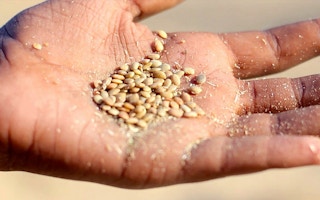Planting more lentils, chickpeas and other pulses will improve the health of the world’s soils that have reached critical levels, threatening to worsen hunger and poverty levels, the U.N. Food and Agriculture Organisation (FAO) said on Monday.
About a third of the world’s soils are degraded because of soil erosion, contamination, urbanisation and other issues.
This is a rise from the early 1990s, when it was estimated to be between 16 and 24 per cent, said Ronald Vargas, soils and land officer at the U.N. agency, and co-editor of a report published on Monday.
With cities expanding and taking up more land, and the population growing and needing more food, the pressure on remaining land is growing.
“If our soil is not healthy enough, we will have serious issues,” Vargas told the Thomson Reuters Foundation.
It will take 15 years or more and a huge amount of investment to restore the soil, he said.
Pulses transfer nitrogen from the atmosphere to the soil and can be grown practically anywhere. Cereals grown after pulses yield 1.5 tonnes more per hectare, equivalent to adding 100 kilos of nitrogen fertiliser, the FAO report said.
“Soils and pulses embody a unique symbiosis that protects the environment, enhances productivity, contributes to adapting to climate change and provides fundamental nutrients to the soil and subsequent crops,” FAO director-general Jose Graziano da Silva said in a statement.
The main form of degradation is soil erosion - the loss of the topsoil by wind, rain or excessive use of machinery. The world is currently losing soil 10 to 20 times faster than it is replenishing it, according to the FAO report.
It takes nature between 100 and 1,000 years to produce 1 cm of soil, and if poorly maintained it can be lost in a single rainfall, or high wind, Vargas said.
“
If our soil is not healthy enough, we will have serious issues.
Ronald Vargas, soils and land officer, UN FAO
“It is almost impossible to bring back that soil loss. So what you can do is try to avoid losing more,” he said.
A study in India shows how growing pigeon peas reduced soil runoff and erosion by up to 59 percent, according to the report.
Healthy soil acts like a sponge, absorbing even very heavy rainfall, and filtering it. If the soil is compacted by overuse of agricultural machinery, or walking, the rain is not absorbed, and instead washes the soil away and may cause flooding.
A layer of healthy soil also reduces harmful greenhouse gases. The first metre of soil contains as much carbon as exists in the atmosphere and all vegetation combined. If it is poorly managed, carbon is released into the atmosphere, Vargas said.
The consequences of not managing soil better are serious, Vargas said.
“We will be facing poverty, we will have more issues of food security … we will not be able to deal with … floods and drought. So we will compromise our future,” he said.
This story was published with permission from Thomson Reuters Foundation, the charitable arm of Thomson Reuters, that covers humanitarian news, women’s rights, trafficking, corruption and climate change. Visit http://news.trust.org.

















